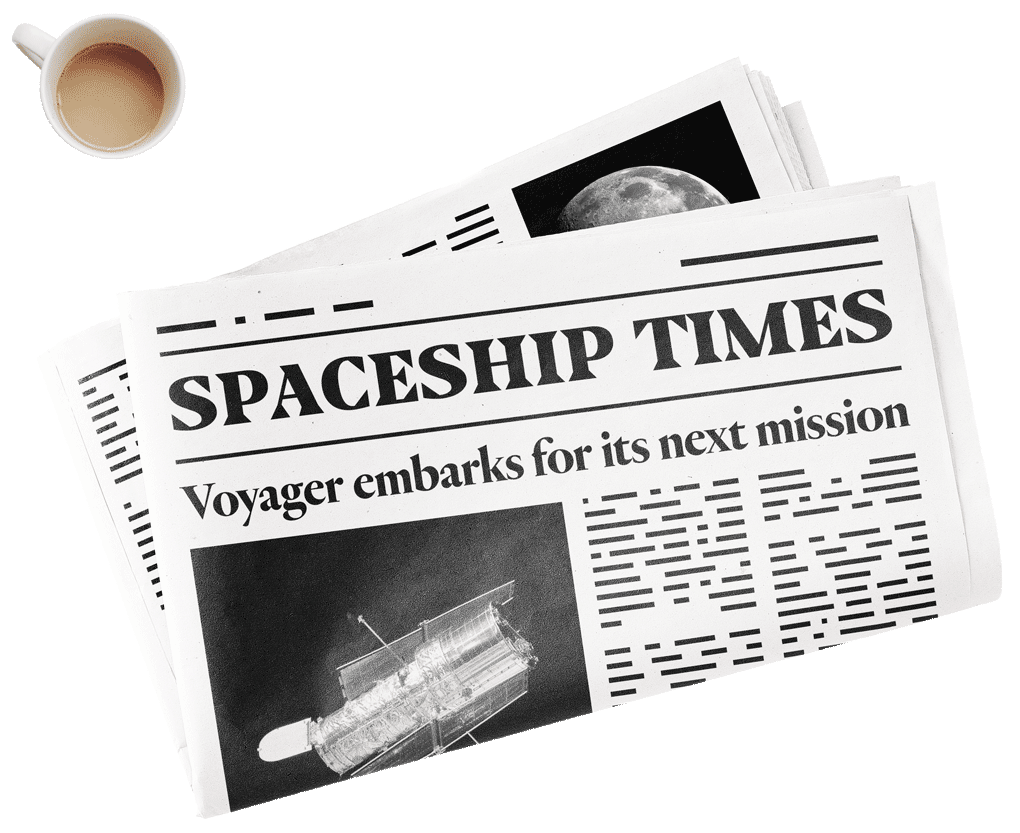Spaceship has a Where the World is Going (WWG) criteria for selecting shares in our Spaceship Universe Portfolio.
We are focused on future trends and in buying businesses that have sustainable competitive advantages or what are called moats.
(This is rather than focus on cyclical companies like financials or mining).
The moat is a defence mechanism designed to prevent other rivals (companies) storming the castle (the industry) and keeping the treasure (cash flows) for themselves.
Sometimes the best defence is the best offence and if you’re innovating (building an army), you have a way of actively attacking other castles while protecting your own moat.
It also forces Spaceship to avoid companies operating in fields that are suffering structural decline.
If a company’s fundamentals change or there’s a dramatic shift in the market, we revisit our criteria and adjust the portfolio.
That’s so you don’t end up holding Blockbuster shares when the world begins streaming, you hold Netflix instead. Or holding Kodak instead of Apple or Samsung. Or Encyclopedia Britannica instead of Google.
Structural decline refers to industries that are experiencing some fundamental change; like the advent of the internet sent thousands of newspaper businesses bankrupt and the invention of the smartphone inadvertently sent some torch or flashlight businesses broke.
So how do we identify a solid moat
There are seven factors to consider when identifying how wide a moat is. (The wider the moat, the better. More chances for rivals drowning etc.)
I’ve put these in no particular order because Spaceship considers them separately and depending on the industry, one might be worth more than another. The best companies have multiple moats that strengthen each other.
The factors are: intangible assets, cost advantage (scale), switching costs, how they use technology, network effect, value proposition and the management.
If you’re interested, here’s how we approach each factor.
Intangible assets
These are things like brands.
The brand of a company has a unique economic value that exists beyond the collection of buildings, equipment, staff and the stuff they make.
It’s basically whether people perceive a company positively or negatively.
If people think great things about a brand’s reputation they are more likely to respond well when a company wants to expand its product line. Like, buy the new product.
If they think the brand is lousy, they probably won’t.
Brands are a pretty difficult thing to measure but a good brand can be one of the most powerful moats. (And is generally the most common).
In banker-land this is called “brand equity”.
Valuable brands deliver superior returns over time [^1] - because customers trust and understand them - and they tend to grow their top lines faster than other companies, regardless of disruptions in the market.
Brands are powerful moats but not all brands are created equal. Only some have the power to attract customers and charge premium prices.
Think about how people actually pay more money for branded water. (Though I’m told ‘real’ water drinkers know all water isn’t the same…)
Spaceship ranks brands based on how different they are and if they are powerful enough to command significant pricing power relative to peers.
The more different a brand appears the more the brand can justify a higher price.
We believe the best brands have a:
- Clear purpose;
- Are different (meaningful and salient); and
- Are responsible.
A2 Milk is a good example here. The founder learned that different proteins in milk affect people differently, and cows producing the A1 protein can cause lactose intolerance.
So he built A2 Milk, which is A1 protein-free milk company and branded it as such. It sets itself apart from other milk brands who, if they do have an A1-free product it’s generally sold alongside the product with A1.
Customers trust A2 Milk more because it only sells one type. Its purpose is clear, the difference is noteworthy and it’s based on a health innovation.
People respect that and so A2 Milk has a high brand equity ranking.
Cost advantage
If a business can make their thing cheaper than anyone else, achieve scale and make way more of them, that’s a great moat.
The same applies to businesses that deliver services. If they can provide their service to heaps of people (at scale), that generally allows them to bring the price down and they can step out further from their competitors.
Blackmores, the vitamin and mineral supplement maker, is a good example here. It’s stocked so widely in Australia that it can mass produce its tablets more cheaply every year as it expands.
A cost advantage can also be found in businesses that have massive customer numbers and can create or buy things in bulk to distribute cheaply to them all. Amazon is an example of a business using its scale to acquire and distribute goods at way lower costs than competitors.
Incidentally, Amazon is one of the reasons so many companies are on their toes; their cheap distribution model could easily alter the underlying structure of an industry.
Cost advantages are also why we are so interested in software businesses. They cost very little to operate, but are able to distribute their product cheaply and (sometimes) infinitely across the world.
But sometimes it’s difficult to isolate the cost advantages when looking at a business. The rapid globalisation of enormous businesses mean your cost advantage in Australia one day, might be wiped out the next by the arrival of a new player.
As such, Spaceship prefers businesses in concentrated industries, like duopolies and monopolies who control the vast majority of the market share.
Blackmores, aside from being an established Australian supplier, has also managed to capture the eyes of Chinese consumers who are hungry for health-conscious products and don’t trust their local offerings. As Blackmores continues to expand throughout Asia, its cost competitive moat will widen.
Another example is Intuitive Surgical, a company that invented a robot doctor called the da Vinci Surgical System. (It’s basically a four-armed, incredibly precise robot that a surgeon operates from a console next to the patient).
It is firmly embedded in thousands of hospitals around the world and is becoming more well known each year, as doctors trust the machine more and more. As more orders come in, it becomes cheaper for Intuitive Surgical to make them (cost advantage) and the brand is becoming widely recognised and trusted (high brand equity).
That said, the rapid way the world innovates now, mean new inventions are always around the corner that could allow a new business significant cost advantages.
We’re always watching this.
Switching costs
If it’s really expensive for you or difficult to switch phone plans, it’s likely you might not bother. Telstra has relied on this strategy for years.
As is the idea of moving your entire media library (photos, music, files) from one operating system to another. Establishing new accounts and passwords for new applications becomes more nauseating as time goes on.
Switching costs lock customers into a company’s unique ecosystem and make it too expensive or too time consuming to move.
Apple has designed a remarkable ecosystem where the switching costs often dissuade people from finding a better deal. Even when the 2016 suite of new MacBooks included only USB-C and Thunderbolt 3 ports, there was almost no drop off in customers, despite the incompatibility of people’s existing accessories.
As this clip so clearly demonstrates:
https://www.youtube.com/watch?v=-XSC_UG5_kU
As such, businesses with high switching costs catch investors’ eyes because it’s likely their customers will stick around for longer.
Spaceship analyses a few different switching costs in order to establish whether or not we like a company.
Is the company providing something specialised?
Autodesk developed AutoCAD; the most-used architecture and engineering software in the world. Part of being a competent architect or an engineer is based on your ability to use AutoCAD and it’s an integral part of university training in both industries.
The switching cost to something new would take a tremendous amount of effort and a deep shift in the actual labour markets of those industries.
As such, the switching cost moat for Autodesk is extremely high and attractive.
Is the value proposition of switching low? (Will customers actually get something new or better somewhere else? If not, then the value proposition of switching is low.)
Changing banks is a good example here. One bank is a lot like another. But the hassle of switching all of your cards, accounts, direct debits and business transactions is a customer headache for essentially the same service.
Intuitive Surgical also has a high switching cost ranking, given the implementation of its machines are time consuming and take training to use.
Technology enablement
Apologies for that term ^^ it’s dreadful.
But it basically means the ways in which companies use technology to do their stuff better, more quickly or enables a much closer relationship with their customer.
The more direct the relationship with the customer, the greater the moat. If you know precisely the needs of the people using your stuff, and you can act quickly on anything new they want, why would they ever leave? They might even pay more for your thing or service!
That’s why companies around the world are obsessed with collecting and analysing customer data.
Domino’s Pizza International is a good example of a company that effectively leveraged new technology to better serve their customers. Domino’s suffered from a serious image and sales problem (low brand equity) in the mid 1990’s but managed to leverage the proliferation of the internet to better serve their customers.
They introduced online ordering, then mobile ordering, then GPS tracking of the pizza order and developed portable warming ovens. Domino’s has also experimented with drone delivering and self driving cars.
The company is relentlessly trying to make the ordering process easier for customers, and since it began doing that so long ago, it has an exceptionally rich collection of behavioural data.
Netflix also leverages an algorithm that collects information on your viewing habits so it can serve up TV shows and movies that you might like. 80% of Netflix viewing comes from recommendations, it's a personalised TV service for users. This is the same artificial intelligence technology that Spotify, YouTube and Facebook use.
These guys leverage technology extremely effectively; it cuts out costs and also makes their products infinitely better.
Network effect
This is when the more people who use a product the more useful it becomes.
For example, social media platforms are only useful when lots of people are on them. So more people sign up because they are so useful, making them even more useful...
Supply drives demand which creates more supply and so on, allowing the strong to get stronger.
The network effect is a powerful moat which often results in a “winner takes all” market; where one company has just captured the attention of an ever-growing number of people who are improving the service and increasing the value of the business every day. Owning shares in those companies often offers considerable revenue growth.
The chief hurdle for any company hoping to build the network effect is to get enough users initially so that the network effect takes hold. Lots of startups, for example, have nifty ideas, but they will only become valuable once lots of people are contributing to the network.
The amount of users required for significant network effects is often referred to as critical mass. After the critical mass is attained, the good or service should be able to obtain many new users since its network offers utility.
Credit card companies have leveraged the network effect for years. The more places accept a credit card, the more people will use the card, which means more places will accept the card.
This can sometimes be an ever widening moat, because even if a cheaper card or product comes on the market, because that card isn’t accepted everywhere, people will pay more for the convenience. Visa is much more widely accepted than Amex, for example.
✅ Read more on the network effect here.
Management team
Spaceship believes that often the right founder gives a company a competitive advantage.
Founders or managers have traditionally outperformed the index [^2] because of the ‘owner mentality’ and a time frame that is longer than most CEOs. Most CEOs are not great at capital allocation, they typically got the role because of great sales or manufacturing skills. Founders on the other hand tend to be superior at capital allocation (deciding the most effective way to spend the business’ money) because they treat the money like its their own (because oftentimes it is!).
It’s sometimes just a matter of identifying if the executive has their own skin in the game. They are incentivised and think differently than someone who is just paid a salary.
Investor-founders tend to focus on customers, rather than just squeezing money out for shareholders (which is better for long term growth) and are not as concerned with quarterly earnings.
Tencent’s co-founder and CEO Ma Huateng is in the process of spending big. The company is forking out billions of dollars to build out its payments and advertising branches.
As such, over the last few quarters, margins have dropped but investors are generally pretty cool with that. They can see clearly what Ma is doing and trust him to allocate the money effectively over the long term.
Ma owns around 8% of Tencent, and while he’s already made a stack of money off the company, he is still very tied to how the company performs. That kind of relationship is a good indicator for us as investors.
The stories of Jeff Bezos with Amazon, Elon Musk with Tesla and Softbank’s Masayoshi Son are well known and many investors bet on those companies solely because they believe in the founder’s vision.
Another great founder is Frederick Smith who founded and remains the CEO of FedEx. His story is great and his vision to begin the first integrated air-ground delivery system in the 1970s showed some great macro-thinking.
FedEx today benefits immensely from the boom in e-commerce and Smith worked hard over the years to stop this seriously capital-intensive business from going broke. Founder led firms also tend to have a special purpose or business urgency and it translates well over time.
Smith also made an appearance as himself in the Tom Hanks movie Cast Away, which has nothing to do with anything, but knowledge is great, right?
Locally, Kogan’s founder Ruslan Kogan has an enormous stake in the online marketplace business. His vision is data-driven decision making and describes Kogan as “a stats business masquerading” as a retailer.
ASX-listed WiseTech’s founder and CEO Richard White still owns just over 50% of the business.
(In a shocking twist of fate, dudes disproportionately found and run multi-billion dollar businesses on planet Earth.)
We rank the Management Moat based on the ‘owners mentality’, employee ratings and capital management. Founder influenced companies - where the founder is either CEO or on the board - receive our highest ranking. Followed by management that has a significant share holding relative to their salary.
Finally, people in company management who have little ownership relative to their salary show more concern for their career than the company rank last.
Moat trend
How certain are we that the trend this company is making money off will continue?
Just like people, companies have life cycles. Competitors, regulation and new inventions are a constant threat to a company’s moat.
Google is a great example of a business that relentlessly widened its moat to avoid threats. It started with a fantastic search product, but when faced with the mobile threat acquired Android. To use the Android mobile system companies also had to display Google’s app giving them a mobile moat.They also bought Youtube the leading video search engine, widening the moat again.
The trend in internet search is only growing and the established positions Google has in the PC, mobile and video market means the moat is stable.
Value proposition
This is the thing that makes a product different to all the other products in a market.
Think of it like an easy-to-understand reason why someone should purchase a product or service from a company.
Amazon offered a free delivery service, which was a happy value proposition for customers and was a value proposition that set it apart.
Zillow Group not only allows people and agents to advertise properties, they now also can make a bid for those properties. Not many platforms take control of the physical assets.
Twitter allows you to find real-time chatter and information flow with strangers all over the world.
A clear value proposition often remains in people’s heads; a helpful addition to the moat.
The Spaceship WWG rating
So, all of that is the criteria of how we rank companies we might want to buy.
And once we’ve developed a matrix assessing each of the moat factors (intangible assets, cost advantage, switching costs, how they use technology, network effect, the management and moat sustainability), we assign them a Where the World is Going (WWG) rating.
A high WWG ranking suggests a high likelihood that the company has a sustainable competitive advantage that allows it to generate economic profits for its owners over an extended period. That’s great for our purpose; we are long term investors who are happy to ride out market fluctuations as long as the business is operating powerfully.
But as we discussed, not all moats are equal; the strongest companies typically have a number of moats and we gravitate towards those types.
And ultimately, whether or not the business can keep making money over a long period of time is the crux of our investment decision. Sustainability of profits, that’s our make or break measurement.
But the first step is analysing the moat.
Conclusion
The moat is designed to prevent other rivals (companies) storming the castle (the industry) and keeping the treasure (cash flows) for themselves.
Using seven factors we assign a ranking to each company and are constantly assessing whether a company is consistently meeting our criteria.
If it doesn’t, we will remove it from the portfolio.
But these portfolio adjustments don’t happen often and always with a really long time horizon.
Spaceship isn’t going to drop a company just because it had a difficult year or buy a new platform because it’s the hottest new stock.
This is a long term play and hopefully this post helped show how we think about investing.



